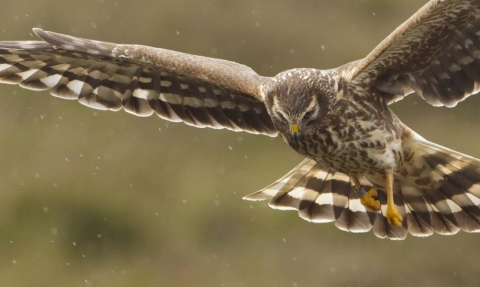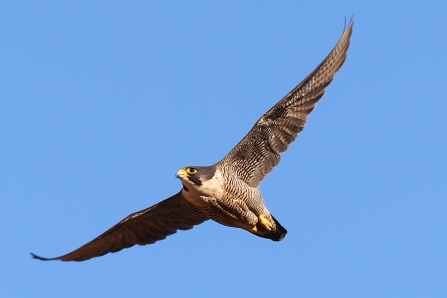
Hen Harrier, Mark Hamblin, 2020 Vision
Hen Harrier Day
Background
Hen Harrier Day was created to help celebrate these iconic birds and to raise awareness of the issues that they, and many other upland species, face.
Sadly, our beautiful hen harrier is just one of the many species experiencing losses and, as with many birds of prey, the hen harrier struggles to thrive due to human persecution (poisoning, shooting, and trapping).
Raptor Persecution
Throughout the UK, birds have seen a gradual decline for the last few decades, but the loss of bird species has accelerated substantially in recent years. In the last 25 years, we have seen the number of birds on our Red List doubling and have lost around 19 million breeding pairs of birds in the UK since the 1960s.
We need to act now if we want to help our birds to thrive. This year, you can help us raise awareness of the struggles our UK birds of prey face and help to raise money for projects that will support Derbyshire’s birds of prey.
Click below for more information.
Hen Harrier Fundraising
Over the last three years, we have run our Hen Harrier Day themed anonymous art auctions. Professionals and amateurs, children, and adults all took part by creating and donating art for us to help raise awareness of the plight of the hen harrier and our uplands. In total, we received over 190 pieces of art which raised a whopping £11,948 for our wildlife.
Creative Writing Competition
We partnered with Writing East Midlands for their Solstice Prize competition.
The Solstice Prize is our annual showcase for young writers, seeking imaginative short stories and provocative poems, with prizes on offer for winners in three age groups: 7-11, 12-14, and 15-17.
The winning entries are often full of powerful and poignant language which makes us laugh or cry, or simply shines a light on something truly original. Many also have a subtext which makes us stop and think, and keeps us guessing to the end.
Click on the link below for the digital anthology:
Art Auction
To see the previous year's artwork click on the link below.

Peregrine, Dave Nay, via Flickr
FAQs
Why are hen harriers special and important?
The hen harrier is an iconic species. The combination of its beauty, charisma and rarity make this a highly cherished and valued bird. Hen harriers are particularly associated with heather moorland where they breed in deep vegetation like tall heather, rushes or bracken. Hen harriers are birds of prey, eating a range of small animals – mostly mammals like voles but also small birds. They hunt by quartering the moors – almost floating across the hillsides in the search for prey rather like day flying owls.
They breed on our uplands and moors, and they are ground nesting birds. The female remains incubating the eggs and chicks whilst the male does most of the hunting. The male passes prey in mid-air to the female to return to the nest in an acrobatic aerial display.
What is the problem?
The hen harrier faces many threats. In some areas it is in decline because of loss of habitat but by far the largest threat it faces is illegal persecution; it is one of the most persecuted birds of prey in the UK, shot and trapped, despite being legally protected.
For a few weeks in late May and June, hen harriers will feed on grouse chicks. At this time of year, the chicks are small, abundant and easy to hunt. For the remainder of the year, red grouse are pretty much safe from predation by harriers because of their size.
This small window of hunting for grouse chicks brings hen harriers into conflict with grouse moor managers who rely on plentiful supplies of grouse for shoots which will take place later in the summer and autumn. In addition the presence of adult hen harriers flying over a moor on a shoot day can spook the grouse and make it difficult to shoot. This is a sensitive issue because the annual income for the grouse moor manager can depend on being able to have just a few days of successful shooting.
As a result, many in the grouse shooting industry feel that the presence of hen harriers can make shooting uneconomic. So the hen harrier finds itself in a predicament faced by so much of our wildlife, trying to find a foothold in the face of competing demands for habitat, space and land.
Why should we protect hen harriers?
In addition to the message that these are precious and iconic birds worthy of conservation in their own right, almost everyone has an interest in preventing the illegal persecution of hen harriers. It will help the birds to recover – and recreate the full range of species which should be present on English moorlands, it will help conservation organisations and the police who can divert their resources to other much-needed work and it will help responsible land managers who do not tolerate crimes against birds of prey on their land, whose reputation would no longer be damaged by those who choose to act outside the law.
Hen harriers are precious and iconic birds worthy of conservation in their own right. Almost everyone has an interest in preventing the illegal persecution of hen harriers. It will not only help the birds to recover – and recreate the full range of species which should be present on English moorlands, it will also help conservation organisations and the police who can divert their resources to other much-needed work. Responsible land managers, who do not tolerate crimes against birds of prey on their land, will also benefit as their reputation would no longer be damaged by those who choose to act outside the law.
Our position on the alleged killing of hen harriers
Derbyshire Wildlife Trust is totally opposed to the illegal persecution of all wildlife – including hen harriers. We have added our support to Hen Harrier Day to oppose the illegal persecution of one of the UK’s rarest birds. We are also concerned about the illegal persecution of other upland birds of prey such as peregrine and goshawk.
Hen harriers can be found in Upland habitat, what are The Uplands?
‘Upland’ is a geographical term which refers to areas which are high (200-500m) above sea level and often mountainous. They cover about 40 % of the UK land surface. Nearly two thirds of UK uplands are designated landscapes, either National Parks or Areas of Outstanding Natural Beauty, valued for their scenery, their sense of remoteness, scale and cultural and natural heritage. In Derbyshire, the Peak District covers most of our upland areas.
Many different and varied habitats can be found in upland areas such as, acid grasslands, birch woodland, blanket bog and moorland.
Why are our Uplands so important?
Our upland areas are nationally and internationally important for many reasons and as such need our protection. In fact some of the habitats are so important that they are afforded special protection measures such as Sites of Special Scientific Interest (SSSI), Special Areas of Conservation (SAC) and Special Protection Areas (SPA).
These special places are not only home to internationally important wildlife including iconic species like the mountain hare, hen harrier, curlew, lapwing, black grouse and ring ouzel, but they also provide some very important services for us too:
Clean water provision:
In the UK, around 70% of our drinking water comes from surface water (water which falls as rain and collects on the ground) gathered in upland areas and if the habitats are healthy, clean water makes its way into our water supply system.
Carbon sinks:
On moorlands (one of the main upland habitats) soils tend to be waterlogged and acidic, this creates anaerobic conditions where bacteria in the soil have to live without oxygen and work slowly. These conditions mean that dying plant material does not decay fully and instead builds up to form the peat (a type of soil).
Plants take in carbon when they were growing (they use it to make glucose during photosynthesis) and usually when they die and decay this carbon is released back into the atmosphere, however in peat soils, the carbon gets trapped, keeping it out of the atmosphere and reducing the carbon that can contribute to climate change. Peat moorlands hold (sequester) about 30% of the worlds soil carbon and as such are known as valuable carbon ‘sinks’. Upland peatland and peaty soils are the largest carbon stores in England, storing an estimated 138 million tonnes of carbon.
Flood Prevention:
Upland areas experience high amounts of rainfall and this water feeds into our river systems. If the habitats are healthy, these habitats retain water and slow down its movement into the rivers and hence reduce the risk of floods further downstream.
What Problems are uplands facing?
Sadly our uplands are in trouble, The State of Nature report revealed a staggering 65 per cent of upland species assessed had declined, with a third of species showing strong declines.
Large parts of our upland habitats have been damaged through poor management. Upland heath has declined by more than 25% since the late 1940’s and blanket bog declined 21% between 1940’s and 1980’s. Many of the protected areas are in poor shape, principally caused by inappropriate grazing, poor burning practice and drainage of bog and wetland in an attempt to improve soil productivity for farming.
When the peat soils dry out, they stop accumulating and acting as a carbon sink and start instead to release thousands of years of stored carbon back into the atmosphere. The bare, dry soils also retain less water, rain runs off into rivers faster and hence the flood prevention ability of these habitats is lessened.
Damaged, dry soils also increase the sediment load of rivers, as particles are washed into the rivers with the rain water, this causes brown discolouration of the water and increased water treatment costs.
The hen harrier is a symbol for all the species and ecosystems we wish to see thrive.Derbyshire Wildlife Trust
